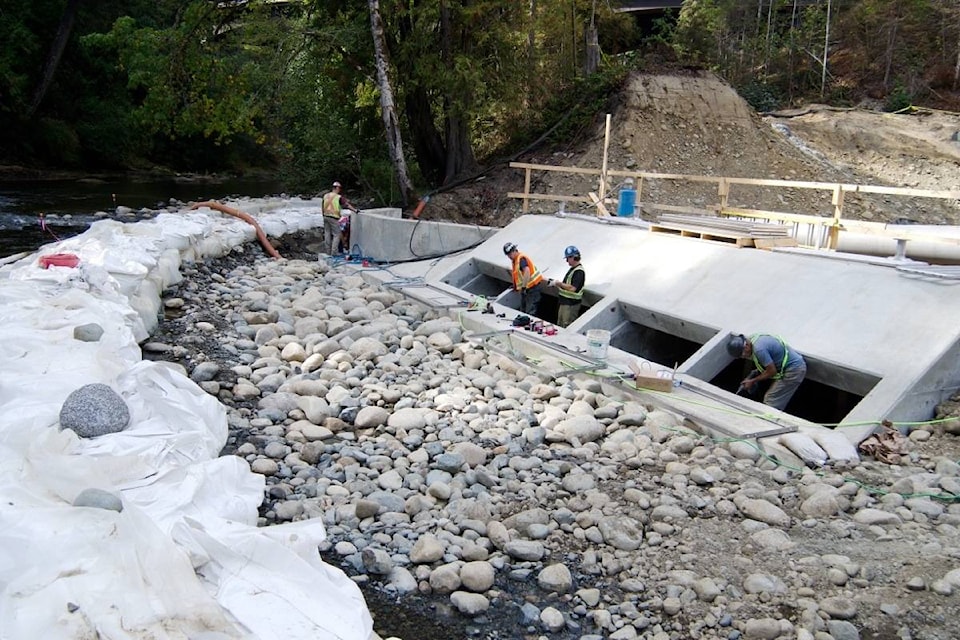This is the second in a three-part, weekly series on the Englishman River watershed and the City of Parksville’s efforts to upgrade its water supply capacity for the coming years.
Amid a serious disagreement over the amount of water available to the City of Parksville from the Englishman River, the current crisis of summer water restrictions has less to do with the volume of water in the river than with the ability of a 40-year-old intake and distribution system to draw it out, says the city’s water project manager.
“The straw’s too small,” said Mike Squire, city operations manager. “We can’t get enough water out of the river. The system has reached its lifespan.”
A $34.5-million water intake and distribution project now underway will breathe new life into the water system serving both Parksville and Nanoose Bay, though critics argue it will do nothing to add water to a key salmon-bearing river that is facing pressures from ongoing development and global climate change.
Related: Englishman dam ensures Parksville’s water supply
Currently, Parksville and Nanoose Bay, which will be supplied by the Englishman River Water System (ERWS), receive most of their water from area wells, with the ERWS supplying supplemental water during the dry summer months.
When the new intake and transmission system is commissioned and placed into service in 2019, the immediate benefit will be to allow more water to be pulled from available supply in the Englishman River, said Squire.
Longer-term, it is expected to relieve pressure on the regional aquifer by providing water to Parksville and Nanoose Bay year-round, according to a 2016 Geological Survey of Canada study of the Nanoose Bay to Deep Bay lowland groundwater supply system, undertaken with the Regional District of Nanaimo.
“This is a favourable option to serve a growing population, while protecting local aquifers as groundwater levels have declined in the Parksville area over the past several years,” the Geological Survey of Canada report stated.
The current intake system, said Squire, consists of a series of horizontal well “fingers” running into the river and covered with screens, which periodically need to be cleaned out by city workers.
The new system will collect water as it flows along the riverbank, through specially designed, “fish-friendly” screens that will prevent the uptake of fish and other debris.
“Before we commited to this, we went down to Washington State and toured three of these types of intakes,” said Squire. “They’re actually (fish) hatchery screens.”
Squire said there will be a blower system built into the uptake bumper which will release a burst of air as needed to blow away any debris that collects on the screens.
That will eliminate employees trampling through the river to clean screens, which the Department of Fisheries and Oceans frowns upon, said Squire.
The placement of the new intake, just upstream from the Highway 19 bridge crossing (and upstream from the current intake) was a bit of a balancing act between the wishes of DFO and Island Health, which monitors the system’s water quality.
“DFO would like us to be as far downstream as possible, because that leaves more water for the fish,” said Squire. “Island Health wants us as far upstream as possible to get away from human habitation and contaminants.”
The intake system will be equipped with four vertical pipes, each of which can be fitted with a pump to send water to the water treatment centre just upslope, behind the city’s operations building in Parksville’s Industrial Area. Only two pumps will be used for the foreseeable future, but the capacity will be in place to add two more to serve the need as the population grows, Squire said.
“These pipes are built for the future,” he said. “It’s OCP build-out plus. You only want to be in this kind of environmental area once.”
The new water treatment facility is designed to minimize the wastewater screened from the system, with two tanks in place to collect the waste. Currently, the city has to pump waste off to the sewer, and then on to the Regional District of Nanaimo’s waste treatment centre in French Creek.
“Instead of 95 per cent efficient, this system will be 99.3 per cent efficient,” said Squire. He added that lower volumes of chlorine would need to be added for residual contact because of the clarity of water that will result from the filtering process.
The water will then be piped back out of the treatment plant to a pair of new transmission mains supplying the system’s above-ground reservoirs at Springwood Park and at Top Bridge Park.
